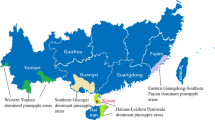Abstract
Genetic modification of trees presents great advantages but it is hampered by the possible spread of introduced genes to native populations. However, the spread would be prevented if the modified trees would be sterile. We have previously shown that the induction of sterility by the prevention of flowering is possible in tobacco and Arabidopsis by introducing a gene construct composed of the ribonuclease gene BARNASE ligated to the flower-specific promoter of the birch gene BpMADS1. In the present study, we test this gene construct in silver birch (Betula pendula Roth). When this gene construct was introduced into very early-flowering birch clones, 81 kanamycin resistant lines were obtained. In 38 lines, the vegetative development was disturbed, e.g., the leaves were small and the plants were short and bushy or the growth of plants was weak. More importantly, in 7 other lines no male inflorescences formed or they aborted early. If male inflorescences were formed, they did not contain any stamens. The initial growth of these lines was similar to the non-transgenic control lines. Later, however, the growth of the non-flowering lines differed from that of the controls in showing some dichotomic branching and a reduced number of branches. Preliminary results showed that the gene construct can prevent the development of female inflorescences as well. The results show clearly that BpMADS1::BARNASE can prevent the flowering in a tree but the prevention of flowering may cause some side effects. Studies with ordinary birch clones will show whether the side effects are a property of the early flowering clones or all birches.
Similar content being viewed by others
References
Brunner A.M., Mohamed R., Meilan R., Sheppard L.A., Rottmann W.H. and Strauss S.H. 1998. Genetic engineering of sexual ste-rilityin shade trees. J. Arboriculture 24: 263–273.
Burgess D.G., Ralston E.J., Hanson W.G., Heckert M., Ho M., Jenq T., Palys J.M., Tang K. hv Gutterson N. 2002. A novel, two-component system for cell lethality and its use in engineering nuclear male-sterility in plants. Plant J. 31: 113–125.
Caporali E., Spada A., Losa A. and Marziani G. 2000. The MADSbox gene AOM1 is expressed in reproductive meristems andflowers of the dioecious species Asparagus offýcinalis. Sex. Plant Reprod. 13: 151–156.
Gross H.L. 1972. Crown deterioration and reduced growth associ-atedwith excessive seed production by birch. Can. J. Botany 50:2431–2437.
Hartley R.W. 1988. Barnase and barstar. Expression of its clonedinhibitor permits expression of a cloned ribonuclease. J. Mol. Biol. 202: 913–915.
Keinonen K. 1999. Towards genetic manipulation of silver birch(Betula pendula) and Scots pine (Pinus sylvestris). Ph.D. Dis-sertation,University of Joensuu, Joensuu, Finland.
Lemmetyinen J. and Sopanen T. 2004. Modification of floweringin forest trees. In: Kumar S. and Fladung M. (eds), MolecularGenetics and Breeding of Forest Trees. The Haworth Press, Inc.,USA, in press.
Lemmetyinen J., Keinonen-Mettälä K., Lännenpää M., von Weis-senberg K. and Sopanen T. 1998. Activity of the CaMV 35Spromoter in various parts of transgenic early flowering birchclones. Plant Cell Rep. 18: 243–248.
Lemmetyinen J., Pennanen T., Lännenpää M. and Sopanen T. 2001. Prevention of flower formation in dicotyledons. Mol. Breeding 7: 341–350.
Lemmetyinen J., Hassinen M., Elo A., Porali I., Keinonen K., Mäkelä H. and Sopanen T. 2004. Functional characterisation ofSEPALLATA3 and AGAMOUS orthologues in silver birch. Physiol. Plant., in press
Mandel M.A. and Yanofsky M.F. 1998. The Arabidopsis AGL9MADS box gene is expressed in young flower primordial. Sex. Plant Reprod. 11: 22–28.
Pelaz S., Ditta G.S., Baumann E., Wisman E. and Yanofsky M.F. 2000. B and C floral organ identity functions require SEPAL-LATAMADS-box genes. Nature 405: 200–203.
Perala D.A. and Alm A.A. 1990. Reproductive ecology of birch: A review. Forest Ecol. Manag. 32: 1–38.
Stern K. 1961. Über den Erfolg einer über drei Generationengeführten Auslese auf frühes Blühen bei Betula verrucosa. Silvae Genet. 10: 48–51.
Vrtala S., Hirtenlehner K., Susani M., Akdis M., Kussebi F., Akdis C.A., Blaser K., Hufnagl P., Binder B.R., Politou A., Pastore A., Vangelista L., Sperr W.R., Semper H., Valent P., Christof E., Kraft D. and Valenta R. 2001. Genetic engineering of ahypoallergenic trimer of the major birch pollen allergen, Bet v1. FASEB J. 15: 2045–2047.
Yu H. and Goh C.J. 2000. Identification and characterization of three orchid MADS-box genes of the AP1/AGL9 subfamily dur-ingfloral transition. Plant Physiol. 123:1325–1336.
Author information
Authors and Affiliations
Corresponding author
Rights and permissions
About this article
Cite this article
Lemmetyinen, J., Keinonen, K. & Sopanen, T. Prevention of the flowering of a tree, silver birch. Molecular Breeding 13, 243–249 (2004). https://doi.org/10.1023/B:MOLB.0000022525.96200.53
Issue Date:
DOI: https://doi.org/10.1023/B:MOLB.0000022525.96200.53




